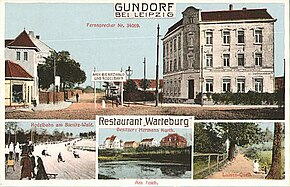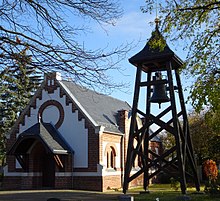Gundorf
Gundorf was an independent municipality northwest of Leipzig until 1934 , was incorporated into Böhlitz-Ehrenberg and has been a district of the trade fair city since 1999.
geography
The district Gundorf belongs to the district of Böhlitz-Ehrenberg in the district Alt-West. The municipality of Neuscherbitz belongs to Gundorf.
history
The first written mention of Gundorf comes from the year 974, when it was the subject of a gift from Otto II to the Merseburg Bishop Giselher von Magdeburg . This makes the place one of the oldest villages in the Leipzig region. In 1269 the Petri monastery in Merseburg was given the right to levy taxes and jurisdiction.
Gundorf Church
The church in Gundorf was built from rubble and mortar as early as the 12th century . The pulpit dates from 1626, the baptismal font from 1720. The galleries were only built in during a renovation in 1902. The church's bells, the oldest of which was cast in 1450, had to be delivered during the Second World War . Three new bells were consecrated in 1959.
Gundorf cemetery
The cemetery is located approx. 500 m south of the Gundorf Church on the road to Burghausen. It also serves as a cemetery for the Böhlitz-Ehrenberg parish . The bell from the Friedenskirche , a gift from the Michaelis-Friedens-Kirchgemeinde, was installed next to the chapel in 2013.
Gundorf Castle
In the course of secularization , the abbey and monastery property came to the sovereign, who sold it to the farmer Valentin Kietz. In 1661 the village came into the possession of the Leipzig chief judge J. Fritzsche, who already owned the Scherbitz estate ( Altscherbitz , abbey estate ) . The Gundorfer Klostergut has been since thenCalled Neuscherbitz . The manor house of the manor was built in 1720 by Johann Ernst Kregel von Sternbach . The adjoining park was designed by Peter Joseph Lenné .
In 1814 there were 17 farms in Gundorf. Their lands gradually became the property of the manor, so that there were only a few independent farms left in the middle of the 19th century. In 1881 the Leipzig entrepreneur and city councilor Albin Ackermann acquired the Gundorf castle and estate. His monogram “AA”, which was originally located at Villa Ackermann in Leipzig, still adorns the large double doors at the main entrance of the palace. In 1902 the official name "Rittergut Gundorf" was introduced. Erich Ackermann, who took over the manor in 1922, had the small tower added at the beginning of the 20th century. In 1938 he sold the manor for 2.6 million Reichsmarks to the city of Leipzig.
Today there is a riding stable on the site and the building itself has been renovated. At the beginning of the 20th century, the production of adobe bricks had become the most important industry. It was continued into the 1930s. Around 1910 the place was expanded to the southwest with the construction of the country house colony "Daheim am Bienitzwald".
Schlobach's court
After the Schlobach brickworks were closed in 1919, Schlobach's farm was built, which was an independent estate district until 1922 and then belonged to the Gundorf community. The Saxon Ministry of Agriculture granted the estate the status of a state educational institution in 1929. From 1936 the estate served as an internship yard for the Leipzig University for poultry farming. In 1950 the Saxon Ministry of Agriculture and Forestry founded a state training institute for agricultural work here, which was affiliated to the German Academy for Agricultural Sciences in Berlin just one year later . From 1953 Schlobachs Hof belonged to the small animal breeding department of the agricultural faculty of the University of Leipzig. After it was closed in 1992, the estate became privately owned. Since 1995 it has been u. a. used as a riding stables. In 2016, an administrative community bought the farm.
administration
Gundorf was one of four abbey villages until 1815 that belonged to the Schkeuditz district of Merseburg , which had been under Electoral Saxon sovereignty since 1561 and belonged to the secondary school principality of Saxony-Merseburg between 1656/57 and 1738 . Through the resolutions of the Congress of Vienna , the western part of the Schkeuditz office was ceded to Prussia in 1815. Gundorf remained with the eastern part of the Kingdom of Saxony and was incorporated into the Leipzig district office. From 1856 the place belonged to the court office Leipzig II and from 1875 to the administrative authority Leipzig .
In 1934 Gundorf was incorporated into Böhlitz-Ehrenberg. Gundorf was officially called Böhlitz-Ehrenberg West. The Böhlitz-Ehrenberg area had thus expanded to the Saxon-Prussian border. During the district reform in the GDR, Gundorf and Böhlitz-Ehrenberg were assigned to the Leipzig-Land district in the Leipzig district in 1952 , which became part of the Leipziger Land district in 1994 . Since January 1, 1999, Gundorf has belonged to Leipzig together with Böhlitz-Ehrenberg.
The former parish hall is a listed building and serves as a residential building. It was restored in 2013.
Infrastructure
In 1907 Gundorf was connected to the Leipzig tram network due to a private donation from Leipziger Außenbahn AG . Line 7 runs to the center every 10 minutes during rush hour. Gundorf had a stop on the Leipzig – Merseburg branch line until it was closed in 1998 . This was right on the border with Burghausen. For private transport, Böhlitz-Ehrenberg can be reached via the A 9 , Leipzig-West exit, and from there the B 181 (Leipzig – Merseburg).
Gundorf has a primary school with over 400 years of tradition, and Burghausen also belongs to the catchment area. The nearest middle school is in the center of Böhlitz-Ehrenberg, the Max-Klinger-Schule in Grünau is the closest grammar school.
The Schloßkrug at the end of the 7 functions together with the two restaurants in Burghausen as one of the excursion restaurants in Leipzig's extreme west.
economy
The Gundorfer Agrargemeinschaft eG has its seat on the edge of the Leipzig alluvial forest west of Gundorf. It supplies the frischli Milchwerke Weißenfels .
Natural monuments
The Gundorfer Lache is located on Gundorfer Flur and has been a designated area natural monument since 2002 . The 2.3 hectare area lies in the middle of the alluvial forest through which the Alte Luppe flows here . It is particularly worthy of protection as a habitat and retreat for various bird and amphibian species.
Persons connected with Gundorf
- The Dresden lawyer and privy councilor Adam Christoph Jacobi was born in Gundorf in 1638.
- The composer Johannes Weyrauch lived in Gundorf from 1938 to 1972.
- The chamber singer Martin Petzold lives in Gundorf.
Trivia

The modern house in Gundorf was used as the location for the film The job of his life with Wolfgang Stumph .
literature
- Frank Hirschinger : Approved for extermination. Halle and the Altscherbitz State Hospital 1933–1945 . Böhlau, Cologne 2001, ISBN 3-412-06901-9 .
- Cornelius Gurlitt : Gundorf. In: Descriptive representation of the older architectural and art monuments of the Kingdom of Saxony. 16. Issue: Amtshauptmannschaft Leipzig (Leipzig Land) . CC Meinhold, Dresden 1894, p. 45.
Web links
- Gundorf in the Digital Historical Directory of Saxony
- Information website My district of the city of Leipzig for Böhlitz-Ehrenberg
- Website of Schloss Gundorf
- Elementary school website
Individual evidence
- ↑ LVZ of May 12, 2016
- ↑ The Abbey Villages in the Historical Directory of Saxony
- ^ Karlheinz Blaschke , Uwe Ulrich Jäschke : Kursächsischer Ämteratlas , Leipzig 2009, ISBN 978-3-937386-14-0 , p. 84 f.
- ↑ The Amtshauptmannschaft Leipzig in the municipal register 1900
Coordinates: 51 ° 22 ′ N , 12 ° 16 ′ E









